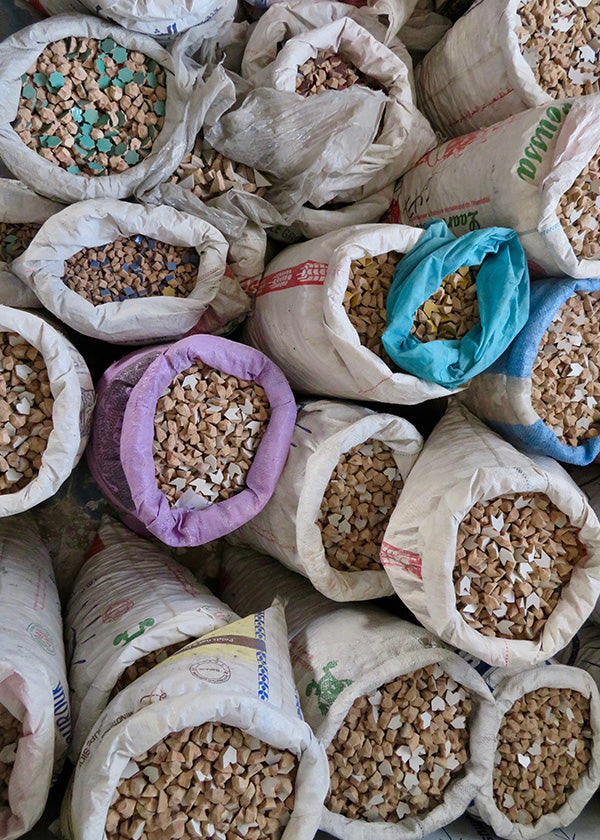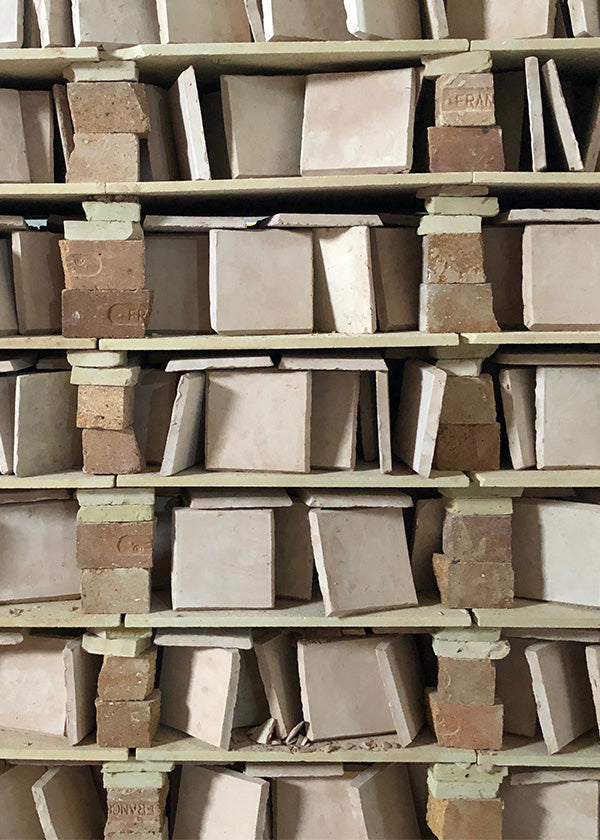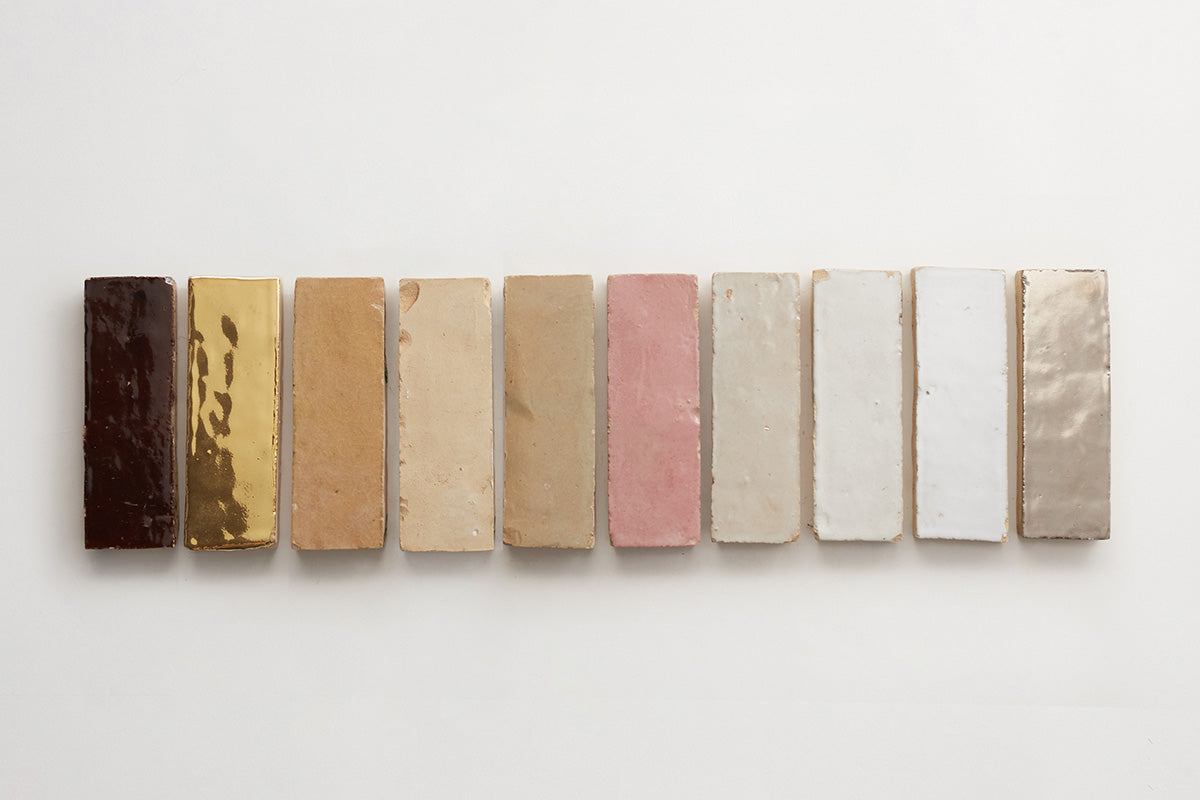what is zellige tile & how is it made?
by clé tile | published: Feb 28, 2024

variety of glazed 2x6 zellige tile
our love for authentic zellige tile runs deep, starting over 25 years ago when clé founder deborah osburn met a tile producer from morocco. his handcrafted tiles were remarkably beautiful, each one unique from the next. jewel-tone glazes, inimitable texture, iron spots here and there—they all came together to create something truly transformative.
now, clé offers zellige in more options than anyone else outside of morocco. we’ve propelled it into full-on popularity, watching it star in magazines and fill instagram feeds all over. as a company dedicated to keeping handcrafted traditions alive, we certainly understand the obsession. and after learning about zellige tile for yourself, you just might too.
what is moroccan zellige tile?
zellige, pronounced zuh-leej, is a type of terracotta tile made by artisans in, you guessed it, morocco. it’s handmade using a process that is considered an art in itself, one that has been passed down by master craftsmen from generation to generation. you may know it as zellij or zillij.
moroccan zellige tile is world renowned for its variegation in surface texture and color. its imperfections are part of the charm and lend an authentic, handcrafted touch to any space you choose to install it in.


history and origins of zellige tile
according to scholars, zellige tile developed in the western islamic world as far back as the 10th century. originally used to adorn islamic palaces and mosques, zellige grew into an intricate mosaic art form you’ll still find in architecture throughout north africa and andalusia today.
the word zellige is actually derived from the arabic word “zilij,” which in turn comes from the arabic verb “zalaja” meaning “to slide.” this is a reference to the tile’s signature smooth, glazed surface.


how is zellige tile made?
traditional mosaic zellige fell out of fashion in most countries in the 15th century, except for morocco. there, artisans have continued using centuries-old techniques to craft the tile entirely by hand.
first, locally sourced natural clay is shaped using rectangular molds and left to dry out in the sun. then, the tiles are further cut and shaped by hand and left to dry once more, all before being hand dipped in glaze. at this point, each tile is methodically placed in a kiln and left to fire overnight. this artisanal process and the uneven heat distribution in the kiln is what gives authentic zellige tile its beautiful variation.
it’s also worth noting that the clay itself can contribute to zellige’s unique variation. because zellige is made from natural, unfiltered clay, it contains lime deposits which may leave pits in the finished tiles. this is part of the charm of zellige, and it’s something to expect along with some chipping, crazing, and cracking.

wood vs gas fired zellige
the most traditional zellige is fired in ancient bee-hive kilns that are fueled by olive pits and branches. wood fired kilns are the most labor intensive, requiring constant attendance. they also do not distribute heat evenly, which in this case is a good thing—it gives each zellige tile the beautiful depth and variation in color it’s famous for.
gas fired kilns bring more temperature control, efficiency, and consistency to the firing process. this runs counter to what gives zellige its unique look in the first place, so traditional zellige is not fired using this method.
what makes zellige tile special?
the color. the texture. the imperfections. the artistry. there’s so much to love about zellige tile, from how it’s made to how it adds a handcrafted feel to virtually any room.
perfectly imperfect
zellige adds a perfectly imperfect touch to any surface it meets. in addition to variations in surface texture and color, zellige tile may vary in thickness and size, with possible iron spots, cracks, crazing, pits, and chips adding extra character.
to better understand what you’ll get when you order zellige tile, always check the color variation key on the product page, which details how much variation to expect with each glaze. our tile variation and imperfections guide is also a helpful resource.
in addition, always plan to order more tile than you will need. we recommend factoring in at least 15% overage to cover tile cuts and breakage. if you are working with zellige tile, you may prefer as much as 30% overage. this allows you to choose exactly which tiles will make it into your final layout. (still, we believe the above imperfections are something to be embraced, not cherry-picked out.)
craftsmanship
zellige tile is as artisanal as it gets, handmade from start to finish using a centuries old process involving hand shaping, sun drying, and firing in bee-hive kilns. in fact, training in the art of zellige traditionally starts during childhood, with the average apprenticeship lasting ten years. after that, it takes many years to become a true master craftsman in the art of zellige.
no two tiles are exactly alike
from the handmade process to the wood fired kilns that heat each tile differently, it’s no wonder that each zellige tile is unique from the next. this is why it’s crucial to blend zellige before the installation process, artfully arranging each tile for an overall look that achieves balance, movement, and harmony.

clé tile zellige neutrals collection in (starting from left) argan brown, gold, riverbed, natural, vesper sands, vintage rose, parched vellum, weathered white, moroccan sea salt and platinum
unique and vibrant colors
the variation of zellige tile gives it color you simply cannot replicate with other types of tile. shades range from elevated neutrals to virtually every color of the rainbow, including honey yellow, emerald green, ocean blue, and chocolate brown. you’ll also find zellige unglazed, showing off its natural pale, warm terracotta hue.
glossy texture
you may remember that the word zellige derives from an arabic verb meaning “to slide,” a testament to its smooth and glossy surface. while many glazed tiles are glossy, none offer the reflectiveness, depth, and variation in texture that true zellige tiles do. zellige’s unique ethereal beauty is what makes it so popular, and it’s why we often describe zellige as the sequins of the tile world.
versatility
we haven’t even gotten to the many ways you can use zellige tile. as you’ll notice all over the world, and especially in north africa and andalusia, zellige tile has been installed just about everywhere.
here in the united states, of course, climate variations do impose some limitations. while you may not be able to install zellige tile on a patio floor or pool waterline in, say, new york, it’s still a beautiful option for kitchen backsplashes, shower walls, bathroom floors, fireplace surrounds, and beyond. (as always, just be sure to check the technical specifications of any particular tile and to consult an experienced professional about your project.)
is zellige tile more expensive?
the cost of zellige tile varies depending on factors such as the quality of craftsmanship, complexity of design, and materials used. generally speaking, authentic zellige tile comes at a higher cost compared to mass produced and more commercially available types of tile. this is a testament to the artistry and labor intensive work involved in crafting true zellige tile. it also speaks to the authenticity of the clay used, which must derive from the fez region of morocco in order to be considered true, authentic zellige. here at clé, we only sell this type of tile.
while weighing the cost of zellige, it’s important to remember that zellige must be installed by a professional who has experience with zellige tile specifically—and who will take the time needed to carefully blend the tiles before installing them. choosing a contractor who has never worked with zellige will likely lead to installation issues. we believe the cost is well worth it, especially considering the many years that zellige will add unique beauty to your home.
how to identify authentic zellige
clé has been central to launching the popularity of zellige tile over recent years, watching it go from an otherworldly finish to a design staple seemingly overnight. this, of course, has given rise to many new and mass produced tile collections, all claiming to be authentic zellige.
if you’re looking to identify authentic zellige tile, whether for a small project or a moroccan inspired house, ask yourself a few questions:
- where is it made? true zellige tile comes from traditional workshops in morocco. whenever purchasing this moroccan tile, make sure it comes from a manufacturer who specializes in authentic zellige production.
- how is it made? unlike zellige tile alternatives, true zellige must undergo a labor intensive process where it is shaped into blocks, cured in the sun, hand cut into tiles, and finally hand dipped in glaze. then, the tiles are fired in ancient bee-hive kilns. these kilns are fueled by olive branches, which create the volatility needed during firing to bring about zellige’s unique depth of color variation.
- does it have imperfections? authentic zellige isn’t your uniform, mass produced fare. it shows the journey of its craft, acquiring beautiful depth, texture, and sometimes even chips and cracks along the way. your tiles will even vary in size and thickness. this is because of the natural, unfiltered, highly imperfect materials used to craft zellige, along with the unique firing process.
- does it have hand cut edges? many people are surprised by the uneven edges found on zellige tile, but rest assured, this is by design. each tile is chiseled by hand at an angle, creating a chamfered edge that’s uneven and irregular. many companies carry a zellige that is not hand chiseled in this way, but if it isn’t hand chiseled, it isn’t authentic zellige.
